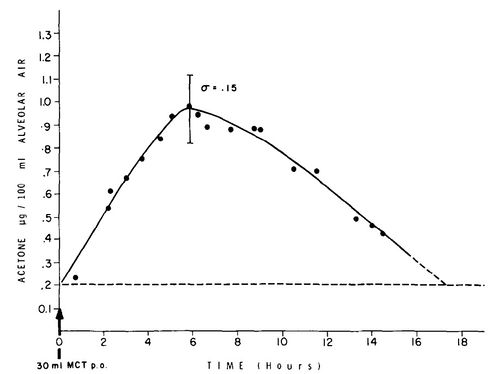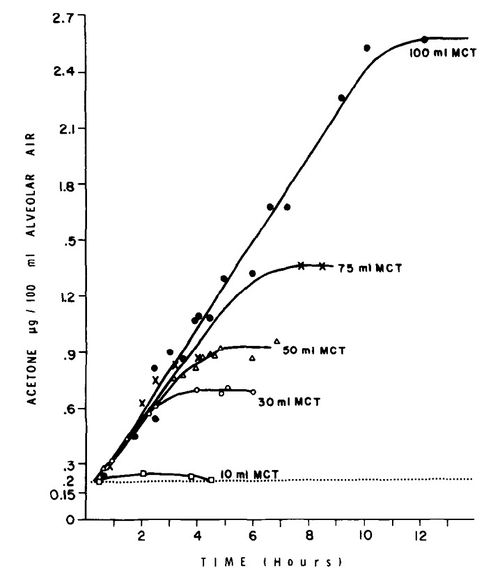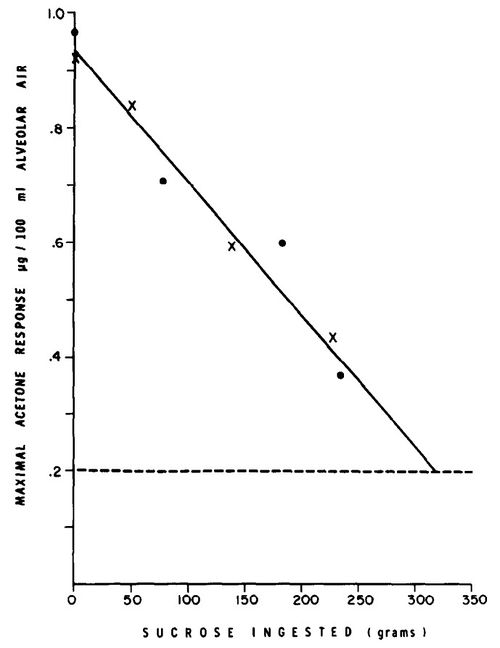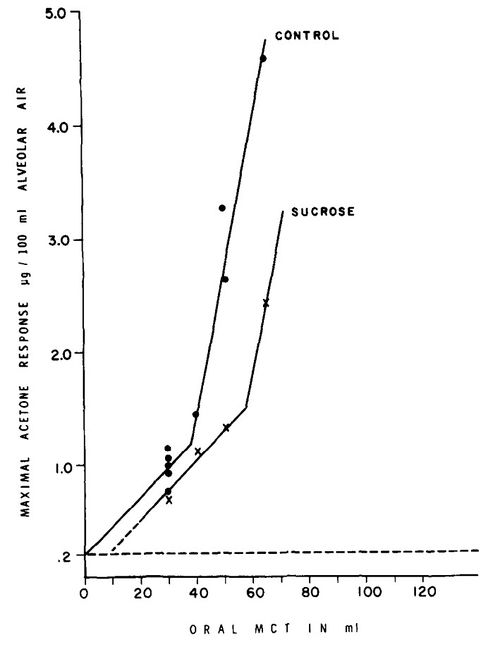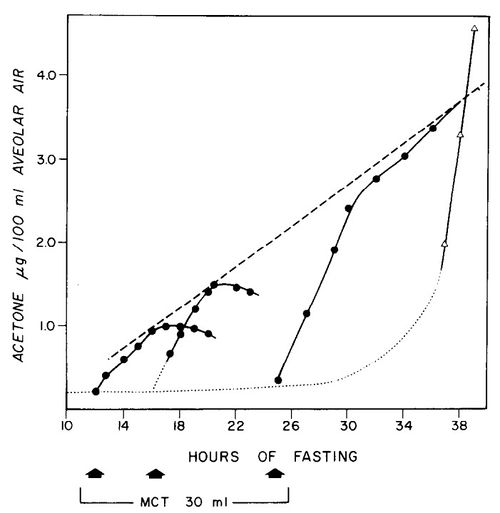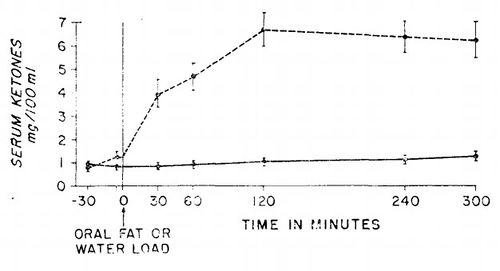MCT - Medium Chain Triglycerides
Medium Chain Triglycerides (MCTs) are fats that are shorter in length than most normal dietary fats (Long Chain Triglycerides or LCTs). MCTs are found in coconut oil, palm kernel oil and butter, as well as being available in pure form.
- MCT produces Ketones even without being part of a Low Carbohydrate Diet.
- Ketone levels are higher when on a Low Carbohydrate Diet.
- Carbohydrate consumption with the MCT will reduce ketone levels.
- Higher intake of MCT will produce higher ketone levels.
- Fasting will increase ketone levels from MCT.
- MCT can produce nausea, vomiting, stomach cramps and diarrhea. Adaptation and mixing with other foods can reduce the problems.
- There are initial indications that MCT will reduce the symptoms of Alzheimer's and other memory problems.
- MCT does not improve exercise performance.
Contents
1 MCT and the Ketogenic Diet
Because MCT will increase Ketone Levels without needing Carbohydrate restriction, they are often used for epilepsy treatment. Small amounts of MCT can be used to increase the ketone levels, or to reduce elevated cholesterol levels while on the Ketogenic Diet[1]. Larger amounts of MCT are the basis of the MCT Diet, which allow for a greater carbohydrate intake than the traditional Ketogenic Ratio Diet and therefore more food choices.
2 MCT Cost
MCT is expensive. I've used pure MCT products like Premium MCT Gold and Dr. Bernd Friedlander MCT Oil, and they are all around $1/oz. You can buy coconut oil, which is about 60% MCT (see below for details), but products like Nutiva Organic Extra Virgin Coconut Oil are about $0.50/oz, which works out around the same price. (Note that products like TwinLab Mct Fuel contain only about 50% MCT.)
3 MCT and Ketone Levels
A 1969 study looked at how ketone levels changed with MCT[2]. Subjects were non-obese healthy adults, mostly on a high carbohydrate diet who did not perform any exercise beyond slow walking after taking the MCT. Unless otherwise stated, the subjects consumed only water after taking the MCT. The study measured breath acetone, which is likely to peak sometime after blood AcAc or BOHB levels. (Note that from another study[3], Acetone at 1.0 µg/100ml breath might indicate blood ketones of BOHB 1.5 mmol/L and AcAc of 0.7 mmol/L, 5.0 µg/100ml might be BOHB 2.7 mmol/L and AcAc of 1.4 mmol/L. See below for details.)
A study showed that giving 40ml of MCT raised blood BOHB levels to 0.43-0.68 mmol/L[4]. Another study showed that 1mg/Kg body weight of MCT raised blood ketone levels to 0.4 mmol after 30 minutes and 0.8 after 120 minutes, falling to 0.7 after 300 minutes[5]:
3.1 Calculating Blood Ketone Levels from Breath Acetone
A study looked at the correlation between breath acetone and blood ketone levels[3]. The results indicated the following relationships between breath acetone in nmol/L and blood ketone levels in mmol/L.
- Acetoacetate (AcAc): Y = AXB + C, where A = 3.4884, B = 0.0803, C = -4.6065.
- Hydroxybutyrate (BOHB): Y = AXB + C, where A = 5.1365, B = 0.0864, C= -6.5048.
- Acetone: Y = AXB + C, where A = 2.2177, B = 0.1900, C = -5.6040.
To convert from µg/100ml used above to nmol/L:
- 1 ug/100 ml is 0.001 mg/dL.
- 0.001 mg/dL is 0.000172 mmol/L.
- 0.000172 mmol/L is 172 nmoml/L.
Plugging this conversion into the above equations, we get:
| ug/100 ml | mg/dL: | mmol/L: | nmoml/L | BOHB | AcAc | Acetone | Total |
|---|---|---|---|---|---|---|---|
| 1.0 | 0.001 | 0.000172 | 172 | 1.5 | 0.7 | 0.3 | 2.5 |
| 2.0 | 0.002 | 0.000344 | 344 | 2.0 | 1.0 | 1.1 | 4.1 |
| 3.0 | 0.003 | 0.000516 | 516 | 2.3 | 1.2 | 1.7 | 5.1 |
| 4.0 | 0.004 | 0.000688 | 688 | 2.5 | 1.3 | 2.1 | 5.9 |
| 5.0 | 0.005 | 0.00086 | 860 | 2.7 | 1.4 | 2.4 | 6.5 |
4 MCT and digestive distress
MCT frequently causes digestive problems, including nausea, vomiting, stomach cramps and diarrhea. There may be several factors that influence the level of digestive distress[6]:
- Quantity. Higher quantities of MCT are more likely to cause digestive distress. One study found that 50g of MCT caused all subjects digestive problems, but 30g only caused problems in 10% of subjects.
- Adaptation. There is adaptation that occurs with consumption of MCT over several days. Two studies showed a reduction in digestive distress over time; in one, subjects were given 34g/day for 7 days and the other, 60g/day for 14 days. By the end the subjects' distress had reduced or disappeared.
- Other Foods. Consuming MCT with other foods reduces the digestive distress.
Personally, I found that even after weeks of taking MCT, I could not consume it on its own without incurring dramatic digestive problems. Mixing MCT with other foods greatly reduced, but did not completely remove, the issues.
5 MCT and Athletic Performance
The available evidence suggests that MCT most likely hinders athletic performance, probably because of digestive discomfort.
5.1 Confounding Factors
The effect of MCT on exercise is not easy to study as there are many factors that might influence the outcome:
- When is the MCT administered? MCT during exercise is likely to have a different result to MCT taken as part of a routine diet.
- Are the subjects on a ketogenic diet? It seems reasonable that Ketoadaptation might change the effect of MCT.
- How long is the trial? There are clear indications that adaptations occur over a period of some days that reduce the side effects of MCT consumption.
- Are the subjects trained athletes or sedentary? Often trained subjects respond differently to their sedentary counterparts.
- What intensity and duration of exercise is used? High intensity exercise usually burns more carbohydrate than fat.
- How much MCT is consumed?
- Is the MCT taken alone or with other fuels? Typically MCT in isolation causes far more digestive problems than when taken with other foods. Also, taking carbohydrate with MCT has been shown to reduce the levels of Ketones produced.
- What is the MCT compared to? Is the MCT compared with the same calorie intake of another fuel, or to no calories?
5.2 Available Research
The table below summarizes the studies on the impact of MCT on exercise.
| Study | Subjects | MCT | Exercise | Result |
|---|---|---|---|---|
| Van Zyl-1996[7] | Trained | During exercise, subjects consumed two liters of
Total of 86g MCT |
2 h at 60% V̇O2max plus simulated 40Km cycling time trail | While the time trial was slower with MCT than CHO, the combination of MCT+CHO was faster. This is the only study I found to show an improved performance with MCT. |
| Angus-2000[8] | Trained | 250 ml/15 min of
|
Simulated 100-km cycling time trial (~150 min, 35 kJ/kg) | Compared with P, C reduced time to exhaustion by 7% and CM by 5%. |
| Jeukendrup-1998[9] | Trained | Either
CHO was ~170g glucose, MCT was ~85g |
2 h cycling at 60% V̇O2max plus 15 minute cycling time trail | The same performance for P, C, CM, but M impaired performance with 17-18% lower work rate. The lower performance with MCT was associated with gastrointestinal complaints. |
| Goedecke-2005[10] | Trained | Either
|
270 min cycling at 50% V̇O2max interspersed with sprints every hour followed by a time trial | Hourly sprints and the time trial were slower with MCT. Half of the participants had GI problems with the MCT. |
| Goedecke-1999[11] | Trained | 400ml at the start then 100ml/10mins of
|
2 h at 63% V̇O2max plus simulated 40Km cycling time trail | No change in performance or difference in GI problems |
| Massicotte-1992[12] | Untrained but fit (60.5 +/- 6.7 V̇O2max) | Either
MCT and CHO were radiolabeled |
2 h cycling at 60% V̇O2max | During exercise, 54% of the consumed CHO and 64% of the MCT were metabolized, contributed 7% (CHO) and 8.5% (MCT) of the energy expended. Both CHO and MCT maintained blood glucose levels better than the placebo. |
| Horowitz-2000[13] | Trained | 1 hour before, either
MCT consumption was ~25g |
30 min cycling at 84% V̇O2max | No change in muscle Glycogen levels, but the addition of MCT did increase glucose uptake at rest. |
| Jeukendrup-1996[14] | Elite | 4 ml/kg at the start, then 2 ml/kg every 20 min of
Subjects consumed ~146g CHO or 87g CHO + 26.6g MCT |
90 min cycling at 57% V̇O2max, either after Glycogen depleting exercise the night before (LG) or not (HG). | Of the MCT ingested, 85% (LG) or 69% (HG) was metabolized during the 60- to 90-min period, contributing 7.6% (LG) and 6.5% (HG) to total energy in that period. |
| IvyCostill-2008[15] | Either
|
60 min cycling at 70% V̇O2max | Energy from fat in C, CM and CL was similar (37-39%), but lower for P. There was no change in perceived exertion. | |
| ÖöpikTimpmann2001[16] | Trained | MCT supplementation for 7 days as 34g/day in two doses, or placebo of cooking oil | Treadmill run to exhaustion at 80% V̇O2max | There was a non-significant (10%) decline in time to exhaustion with MCT. |
| Décombaz-1983[17] | 240 calories of MCT or CHO consumed 1 hour before exercise | 60 min cycling at 60% V̇O2max | Fat and carbohydrate metabolism were unchanged between the two conditions. | |
| Sabatin-1987[18] | Untrained | 1 hour before exercise, 400 Calories of either
|
Cycling at 60% V̇O2max to exhaustion | No change in performance between nutrients. Of the consumed nutrients, 80% of CHO, 45% MCT and 9% LCT was metabolized. |
| Jeukendrup-1995[19] | Trained | 4 ml/kg at the start, then 2 ml/kg every 20 min of
|
180 min cycling at 57% V̇O2max | During the second hour, 72% of the MCT was metabolized in CM-L compared with 33% in M. |
6 MCT and Alzheimer's
There is evidence that MCT can help reduce peoples' memory impairment without carbohydrate restriction[4]. A study using elderly dogs showed a long lasting improvement in cognitive ability with MCT supplementation[20]. There are other anecdotal reports of MCT helping with Alzheimer's symptoms[21].
7 Types of MCT
The 'medium chain' in 'medium chain triglycerides' refers to the length of the chain carbon atoms. Generally, chain lengths of 6 to 12 carbon atoms (C6 to C12) are considered 'medium'. The most common source of MCTs is in Coconut Oil, and typically pure MCT is refined from Coconut Oil. The mixture of oils in most MCT reflects that of Coconut Oil. MCT oils are fully saturated.
7.1 Sources of MCT
The composition of common sources of MCTs is shown below:
|
Coconut Oil[22] |
Palm Kernel Oil[22] |
Butter[23] | |||
|---|---|---|---|---|---|
| Fatty Acid | Typical % | Range % | Typical % | Range % | Typical % |
| 6:0 Caproic | 0.5 | 0.4-0.6 | 0.2 | 0.1-0.5 | 2.0 |
| C8:0 Caprylic | 7.8 | 6.9-9.4 | 3.3 | 3.4-5.9 | 1.2 |
| C10:0 Capric | 6.7 | 6.2-7.8 | 3.4 | 3.3-4.4 | 2.5 |
| C12:0 Lauric | 47.5 | 45.9-50.3 | 48.2 | 46.3-51.1 | 2.6 |
| Total MCT | 62.5 | 59.4-68.1 | 55.1 | 53.1-61.9 | 8.3 |
8 Calories in MCT
An animal study has shown that overfeeding that includes large quantities of MCT produced 20% less weight gain than the same level of overfeeding with LCT[24]. The rats were fed a diet of 50% of calories as fat, with the MCT diet providing 45% of calories from MCT. The rats had similar levels of activity and insulin. This may because MCTs are raise body temperature (thermogenesis)[25]. MCT has is often considered to have a slightly lower calorie density of 8.3 Calories/gram compared with 9.1 Calories/gram for LCT[26]. However, if thermogenesis is taken into account, a value of 6.72 Calories/gram would be more appropriate[26]. This may be critical when using the MCT Diet if calorie intake is restricted. Given the density of MCT is 0.93 - 0.96 grams/ml[27], 15ml of MCT would be 95 Calories assuming 6.72 Calories/gram rather than 118 Calories assuming 8.3 Calories/gram.
9 MCT and Weight Loss
MCTs are sometimes recommended for weight loss. One study compared MCTs with Olive Oil and found a greater weight loss with MCTs[28]. There is some evidence from an animal study that MCTs may be less palatable than other fats[29]. However, an analysis of animal studies indicates that generally, replacing other fats with MCT does not reduce calorie intake[30]. Based on my personal experiences with MCT, I would suspect that any weight loss benefit comes from the appetite reduction that comes from the associated nausea.
10 MCT Safety
MCT is considered safe at 1mg/Kg of body weight, and MCT has been shown as effectively non-toxic in high dose (9-12g/Kg) animal studies[31].
11 My Experiences with MCT
- I've found that taking MCT on its own will often produce digestive problems, including nausea and apocalyptic diarrhea. Mixing MCT with other foods can reduce the problems, and I take MCT with cream or other foods.
- I found that MCT in larger doses (3+ tablespoons) can produce obvious thermogenesis, resulting in the perception that a cold room is actually overly warm. There is also a sensation of warmth radiating from my stomach, rather like I'd just consumed strong alcohol.
- There seem to be changes in mental functioning, especially with larger doses. MCT can alleviate some feelings of tiredness and improve mental acuity, but it can also result in an unpleasant feeling that is hard to describe. The sensation is a little like how I feel when a migraine is imminent.
- I've found that MCT taken during exercise seems to impair my running. I performed a simplistic experiment with MCT during a run to try to evaluate the effect.
- At the time of the experiment I was adapted to the [[Ketogenic Diet], having blood ketones above 1.0 for the previous 10 days.
- I started the run fasted, with my last dose of MCT at 2 PM the previous day.
- For the first 8 miles, I felt really good, with my heart rate and breathing where I'd expect them to be.
- At 8 miles I took 3 tbsp. of MCT with 2 tbsp. of Nutella.
- By mile 10 my breathing had become strained, and I had to slow up slightly to keep things under control. My heart rate was slightly higher, but not enough to explain the breathlessness. My breathing problem peaked at about mile 11, before gradually easing off, though it never returned to normal.
- At mile 19 I stopped for a drink and my blood pressure dropped dramatically. Even crouched down with my head between my knees I was dizzy. After a few minutes things returned to some semblance of normality and I was eventually able to stand up and continued to run.
- A few days later I repeated the test, but took 3 tbsp. of Macadamia Nut Oil with 2 tbsp. of Nutella at mile 8. My breathing remained normal and I had no other problems.
12 See Also
13 See Also
- The classifications and types of Low Carbohydrate Diet.
- An introduction to the Ketogenic Diet.
- My experiences with ultrarunning on the Ketogenic Diet
- My Ketogenic Recipes
- Non-Ketogenic Low Carbohydrate Diets
14 References
- ↑ Eric. Kossoff, Ketogenic diets : treatments for epilepsy and other disorders, date 2011, publisher Demos Health, location New York, isbn 1-936303-10-8, Kindle Offset 1809
- ↑ G. Freund, RL. Weinsier, Standardized ketosis in man following medium chain triglyceride ingestion., Metabolism, volume 15, issue 11, pages 980-91, Nov 1966, PMID 5922367
- ↑ 3.0 3.1 K. Musa-Veloso, SS. Likhodii, E. Rarama, S. Benoit, YM. Liu, D. Chartrand, R. Curtis, L. Carmant, A. Lortie, Breath acetone predicts plasma ketone bodies in children with epilepsy on a ketogenic diet., Nutrition, volume 22, issue 1, pages 1-8, Jan 2006, doi 10.1016/j.nut.2005.04.008, PMID 16183255
- ↑ 4.0 4.1 Mark A. Reger, Samuel T. Henderson, Cathy Hale, Brenna Cholerton, Laura D. Baker, G.S. Watson, Karen Hyde, Darla Chapman, Suzanne Craft, Effects of β-hydroxybutyrate on cognition in memory-impaired adults, Neurobiology of Aging, volume 25, issue 3, 2004, pages 311–314, ISSN 01974580, doi 10.1016/S0197-4580(03)00087-3
- ↑ FX. Pi-Sunyer, SA. Hashim, TB. Van Itallie, Insulon and ketone responses to ingestion of medium and long-chain triglycerides in man., Diabetes, volume 18, issue 2, pages 96-100, Feb 1969, PMID 5763665
- ↑ Ira Wolinsky !!author1!!, Judy A. Driskell !!author2!!, Nutritional Ergogenic Aids, date 25 June 2004, publisher Taylor & Francis, isbn 978-0-203-50770-4, pages 196–
- ↑ CG. Van Zyl, EV. Lambert, JA. Hawley, TD. Noakes, SC. Dennis, Effects of medium-chain triglyceride ingestion on fuel metabolism and cycling performance., J Appl Physiol (1985), volume 80, issue 6, pages 2217-25, Jun 1996, PMID 8806933
- ↑ DJ. Angus, M. Hargreaves, J. Dancey, MA. Febbraio, Effect of carbohydrate or carbohydrate plus medium-chain triglyceride ingestion on cycling time trial performance., J Appl Physiol (1985), volume 88, issue 1, pages 113-9, Jan 2000, PMID 10642370
- ↑ AE. Jeukendrup, JJ. Thielen, AJ. Wagenmakers, F. Brouns, WH. Saris, Effect of medium-chain triacylglycerol and carbohydrate ingestion during exercise on substrate utilization and subsequent cycling performance., Am J Clin Nutr, volume 67, issue 3, pages 397-404, Mar 1998, PMID 9497182
- ↑ JH. Goedecke, VR. Clark, TD. Noakes, EV. Lambert, The effects of medium-chain triacylglycerol and carbohydrate ingestion on ultra-endurance exercise performance., Int J Sport Nutr Exerc Metab, volume 15, issue 1, pages 15-27, Feb 2005, PMID 15902986
- ↑ JH. Goedecke, R. Elmer-English, SC. Dennis, I. Schloss, TD. Noakes, EV. Lambert, Effects of medium-chain triaclyglycerol ingested with carbohydrate on metabolism and exercise performance., Int J Sport Nutr, volume 9, issue 1, pages 35-47, Mar 1999, PMID 10036340
- ↑ D. Massicotte, F. Péronnet, GR. Brisson, C. Hillaire-Marcel, Oxidation of exogenous medium-chain free fatty acids during prolonged exercise: comparison with glucose., J Appl Physiol (1985), volume 73, issue 4, pages 1334-9, Oct 1992, PMID 1447077
- ↑ JF. Horowitz, R. Mora-Rodriguez, LO. Byerley, EF. Coyle, Preexercise medium-chain triglyceride ingestion does not alter muscle glycogen use during exercise., J Appl Physiol (1985), volume 88, issue 1, pages 219-25, Jan 2000, PMID 10642384
- ↑ AE. Jeukendrup, WH. Saris, R. Van Diesen, F. Brouns, AJ. Wagenmakers, Effect of endogenous carbohydrate availability on oral medium-chain triglyceride oxidation during prolonged exercise., J Appl Physiol (1985), volume 80, issue 3, pages 949-54, Mar 1996, PMID 8964761
- ↑ J. Ivy, D. Costill, W. Fink, E. Maglischo, Contribution of Medium and Long Chain Triglyceride Intake to Energy Metabolism During Prolonged Exercise, International Journal of Sports Medicine, volume 01, issue 01, 2008, pages 15–20, ISSN 0172-4622, doi 10.1055/s-2008-1034624
- ↑ Vahur Ööpik, Saima Timpmann, Luule Medijainen, Harry Lemberg, Effects of daily medium-chain triglyceride ingestion on energy metabolism and endurance performance capacity in well-trained runners, Nutrition Research, volume 21, issue 8, 2001, pages 1125–1135, ISSN 02715317, doi 10.1016/S0271-5317(01)00319-0
- ↑ J. Décombaz, MJ. Arnaud, H. Milon, H. Moesch, G. Philippossian, AL. Thélin, H. Howald, Energy metabolism of medium-chain triglycerides versus carbohydrates during exercise., Eur J Appl Physiol Occup Physiol, volume 52, issue 1, pages 9-14, 1983, PMID 6360681
- ↑ Sabatin P, Portero GD, Bricout J, Guezennec CY. Metabolic and hormonal responses to lipid and carbohydrate diets during exercise in man. Med Sci Sports Exerc 1987;19:218-23
- ↑ AE. Jeukendrup, WH. Saris, P. Schrauwen, F. Brouns, AJ. Wagenmakers, Metabolic availability of medium-chain triglycerides coingested with carbohydrates during prolonged exercise., J Appl Physiol (1985), volume 79, issue 3, pages 756-62, Sep 1995, PMID 8567514
- ↑ Yuanlong Pan, Brian Larson, Joseph A. Araujo, Winnie Lau, Christina de Rivera, Ruben Santana, Asa Gore, Norton W. Milgram, Dietary supplementation with medium-chain TAG has long-lasting cognition-enhancing effects in aged dogs, British Journal of Nutrition, volume 103, issue 12, 2010, pages 1746–1754, ISSN 0007-1145, doi 10.1017/S0007114510000097
- ↑ Doctor says an oil lessened Alzheimer's effects on her husband, http://www.tampabay.com/news/aging/doctor-says-an-oil-lessened-alzheimers-effects-on-her-husband/879333, Accessed on 20 October 2013
- ↑ 22.0 22.1 Richard D. O'Brien, Fats and Oils: Formulating and Processing for Applications, Third Edition, date 12 December 2010, publisher Taylor & Francis, isbn 978-1-4200-6167-3, pages 49–
- ↑ NDL/FNIC Food Composition Database Home Page, http://ndb.nal.usda.gov/, Accessed on 18 November 2013
- ↑ A. Geliebter, N. Torbay, EF. Bracco, SA. Hashim, TB. Van Itallie, Overfeeding with medium-chain triglyceride diet results in diminished deposition of fat., Am J Clin Nutr, volume 37, issue 1, pages 1-4, Jan 1983, PMID 6849272
- ↑ EA. Mascioli, S. Randall, KA. Porter, G. Kater, S. Lopes, VK. Babayan, GL. Blackburn, BR. Bistrian, Thermogenesis from intravenous medium-chain triglycerides., JPEN J Parenter Enteral Nutr, volume 15, issue 1, pages 27-31, PMID 1901104
- ↑ 26.0 26.1 D.L. Ingle, A. Driedger, K.A. Traul, D.K. Nakhasi, Dietary Energy Value of Medium-chain Triglycerides, Journal of Food Science, volume 64, issue 6, 1999, pages 960–963, ISSN 0022-1147, doi 10.1111/j.1365-2621.1999.tb12259.x
- ↑ http://www.sternchemie.de/englisch/b02a1_mct_oil_analytik.html, http://www.sternchemie.de/englisch/b02a1_mct_oil_analytik.html, Accessed on 2 December 2013
- ↑ MP. St-Onge, A. Bosarge, Weight-loss diet that includes consumption of medium-chain triacylglycerol oil leads to a greater rate of weight and fat mass loss than does olive oil., Am J Clin Nutr, volume 87, issue 3, pages 621-6, Mar 2008, PMID 18326600
- ↑ NK. Edens, MI. Friedman, Response of normal and diabetic rats to increasing dietary medium-chain triglyceride content., J Nutr, volume 114, issue 3, pages 565-73, Mar 1984, PMID 6699737
- ↑ AC. Bach, Y. Ingenbleek, A. Frey, The usefulness of dietary medium-chain triglycerides in body weight control: fact or fancy?, J Lipid Res, volume 37, issue 4, pages 708-26, Apr 1996, PMID 8732772
- ↑ K.A Traul, A Driedger, D.L Ingle, D Nakhasi, Review of the toxicologic properties of medium-chain triglycerides, Food and Chemical Toxicology, volume 38, issue 1, 2000, pages 79–98, ISSN 02786915, doi 10.1016/S0278-6915(99)00106-4
